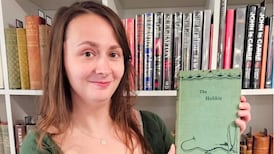Brian Conaghan's third novel, The Bombs That Brought Us Together (Bloomsbury Children's, £12.99), is a clever, entertaining and engaging piece of writing. It may not have quite the immediately mischievous (or scurrilous) appeal of Conaghan's widely popular When Mr Dog Bites but in many respects it is a more thoughtful novel, very carefully composed and gradually seducing its readers with its sense of fun, detail and, as appropriate, seriousness.
A novel balanced between the themes of war and peace, it hosts a cast of larger than life characters, not all of whom may necessarily be the friends or enemies they might at first appear. Guaranteed to keep most young readers enthralled, this sparkling, lively novel will soon find a devoted readership. With occasional sentences such as “My mouth was as dry as Gandhi’s slippers” and one or two lines best left unquoted, a fair degree of laughter is inevitable.
The narrative is focused on 14-year-old Charlie, resident of a locality known as Little Town, an area which borders on the neighbouring territory of Old Country. Conaghan depicts, with great skill, the comings and goings between the two areas, cleverly bringing together the colourful characters – and their misdemeanours – who occupy the landscape.
A degree of diversity is brought to the lives of the inhabitants of Little Town and Old Country with the arrival of Pavel, endowed with his idiosyncratic, and often very amusing, English. Once again, the manner in which Paul is wound into the heart of Conaghan’s story is extremely impressive, not least in his translation of one of the best known of English four-letter words into “Fook”: context is all and much of it is hilarious.
It is a pity that review columns such as this do not,in general, devote more space to information or non-fiction books or whatever terms librarians now use to describe them. By not having the opportunity to enjoy such material, children are missing some of the most colourful reading now available, covering an amazing range of subject matter and style and generally presented in a manner which combines aesthetic and artistic appeal.
Top of my list for this month would be Tamara Bower’s The Mummy Makers of Egypt (Seven Stories Press, £12.99), a superb introductory information book to the world of Egyptology, combining an exciting narrative with dazzlingly executed artwork. The intriguing mysteries of the procedures known as embalming and mummification are exposed as are the personalities and plotting of Egyptian mythology. The creation of a children’s book does not come much more elegant or more thoroughly documented than his: warmly recommended.
The approach adopted by Frann Preston-Gannon in her Dave’s Cave (Nosy Crow, £11.99) is altogether more serious. If it had to be reduced to a single “message”, then “there is no place like home” would fit admirably. Caveman Dave may love his cave: it would seem to have all the conveniences he wants.
And yet . . . There is something in him that yearns for adventure – so off he goes in search of new experiences. Needless to say, the outcome is fairly predictable but nonetheless enjoyable for that and absolutely perfect for reading aloud. Preston-Gannon’s beautifully simple artwork, combined with text pared to a minimum, is an admirable match for her subject. Incidentally, not many children’s picture books come with one of TS Eliot’s best known epigraphs: “We shall not cease from exploration, and the end of all our exploring will be to arrive where we started and know the place for the first time”. It all amounts to a quiet little masterpiece.
Meg McLaren’s debut picture book, Life Is Magic (Walker Books, £11.99) is a noisier offering, packed with circus cheer and good humour. At its centre is the relationship between a magician and his rabbit assistant Houdini, the latter being, perhaps, over-convinced of his own merits and ability. McLaren is particularly good at giving Houdini a central role – “He took care of everyone and everything” – and at inviting audience participation.
Everything looks set for a boisterous evening’s fun until, that is, a night comes when things go wrong. Shazaam! The frequent use of onomatopoeic language enhances the story’s read-aloud appeal.
As McLaren frequently reminds us, Tadaa! or, alternatively, “Everyone is magic because life is truly magic when you share it”. The same could easily be said of McLaren’s accompanying artwork, particularly her portrayal of the delightfully rotund Houdini and his weakness for stray banana skins.
Picture books that incorporate text by Jeanne Willis and illustrations by Tony Ross can hardly go wrong and their Lucinda Belinda Melinda McCool (Andersen Press) is no exception. Are a young girl’s looks all that matters? For Lucinda, yes, as she preens herself on being the most beautiful girl in the school.
Ross’s rhyming story skips along merrily though we know – for we are told – that “not all stories have happy ends”. Poor Lucinda, who has a dreadful fate ahead of her: so much for the vanity of human wishes.
The Natalie of Daisy Hirst’s Alphonse, That Is Not OK to Do! (Walker Books, £11.99) has her Belinda moments, especially when remonstrating with her brother Alphonse on why he should not scribble on her books or, indeed, eat them. Apologies all round eventually restore harmony, though not before we have the opportunity to see some gloriously colourful child art. So, as the story concludes, “they had better draw quite a few more”.
Robert Dunbar is a commentator on children’s books











